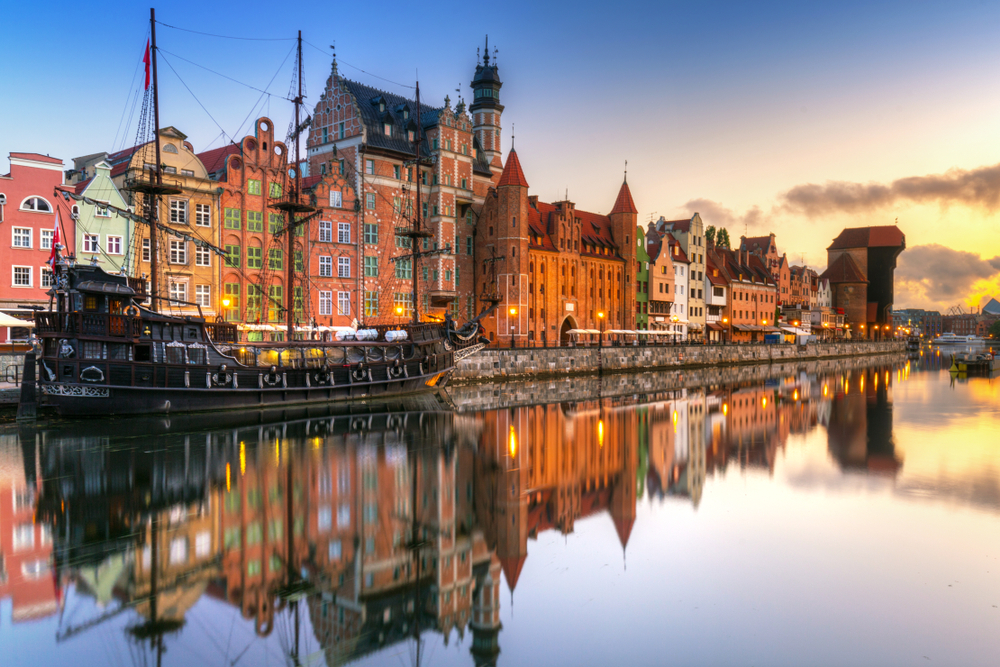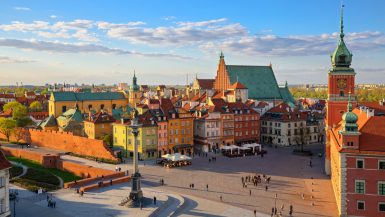The old city of Gdansk is located in the Bay of Gdansk on the Pomeranian Baltic Sea coast. Like a queen, she seems to crown the country of Poland. The current metropolis, which was first mentioned in 980, received city rights in 1240 and was the seat of Slavic princes in its beginnings. Together with Sopot and Gdynia, it grew into the so-called Tricity. Gdansk has always been a transshipment point for long-distance trade. Today, around 470,000 inhabitants live in the lively university city, which has many historical sights to offer. Gdansk is connected to Berlin by the EuroCity, which runs regularly between the two cities. All long-distance trains stop at Gdansk Glowny Central Station, but also at Wrzeszcz and Oliwa district stations.
The beautiful city by the sea is always worth a trip
Gdansk is worth a visit at any time of the year, although on warmer days you can enjoy the hustle and bustle on the streets better. In August, the famous Dominican Market takes place here, to which many guests from home and abroad arrive. The market was created shortly after the city was founded as an indulgence market and is now considered the largest open-air event in Europe. Danzig was often the object of dispute between Poland, Prussia, Brandenburg and the Teutonic Order. That’s why you can still discover many traces of the eventful history here today. Gdansk has several landmarks. They include the Crane Gate, which can be seen from afar, the Green Gate on the Long Market, the mighty St. Mary’s Church in the brick Gothic style, but also modern buildings such as the Baltic Opera and the Baltic Philharmonic.
The main town as a representative of the historic city

Almost all historically significant buildings in Gdańsk are located in the Main Town. The Old Town, on the other hand, is historically less important, because in old Gdansk it was more the district of ordinary people and craftsmen. Both districts are separated by a city wall and have their own town halls. The Rechtstadt Town Hall is definitely worth a visit. Gdansk has a total of 13 historic city gates. In addition to those already mentioned, these include the Hohe Tor, the Häkertor, the Niedertor and the Golden Gate, which is also called Langgasser Tor. In addition to gates, towers, mills and fountains, Gdansk is home to numerous magnificent and colourful town houses and impressive churches. Gdansk was badly destroyed in the Second World War. However, many buildings and facades have been faithfully reconstructed, so that the golden city shines today in its old glory.
Fun and exciting walking tours in Gdansk
The Ratusz Glownego Miasta (Ratusz Glownego Miasta) is a popular motif and can be used as a starting point for an exciting and informative city tour. It is located on the Long Market (Dlugi Targ) in the vicinity of many other attractions. Not far from the town hall is the Neptune Fountain (Fontanna Neptuna), built in 1633, right in front of the Artus House (Dwor Artusa). From here, the Long Street (Ulica Dluga) leads to the City Museum and finally to the Golden Gate (Zlota Brama). Small cafés and restaurants invite you to linger everywhere and you can enjoy the sight of richly decorated facades.
The golden city has many highlights to offer
Most of the city’s highlights are within easy walking distance. From Langgasse it is not far to the Green Gate (Brama Zielona), which can hardly be overlooked. The Frauengasse (Ulica Mariacka), which is considered the most beautiful street in Gdansk, is a must-see. It is located between the embankment of the Motława River and the mighty Church of St. Mary. Some time should be devoted to St. Mary’s Church, because it is one of the largest brick churches in the world. The church tower is 80 meters high. It offers the best view of the beautiful city. Inside the basilica hangs an old astronomical clock at a height of 12 meters, whose puppet play can be admired daily. There are also numerous small shops, restaurants and cafés in wonderfully decorated houses in Frauengasse. The promenade can be reached through the Women’s Gate (Brama Mariacka). From there you can see the well-known Crane (Zuraw), which today houses part of the Maritime Museum.
The gold of the Baltic Sea
It is not far from the Crane Gate to the Wielka Zbrojownia (Armoury) with its magnificent façade crowned with gables and turrets. It is not far from the Amber Museum, where the gold of the Baltic Sea can be admired extensively. The museum is located in the former city prison and the torture chamber can also be visited. By the way, a special souvenir from Gdańsk is not only a piece of jewellery made of amber, but also Gdańsk Goldwasser, a clear and sweet herbal liqueur in which leaves of gold leaf float. If you stay a little longer in Gdansk, which is definitely worth it, you should also explore the surroundings of the city with the Hela peninsula, its dunes, pine forests and picturesque sandy beaches.




